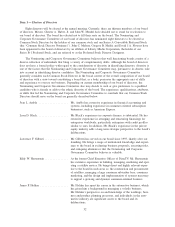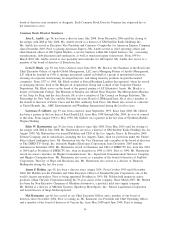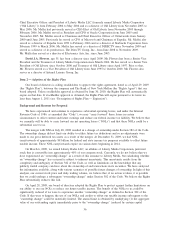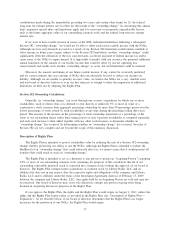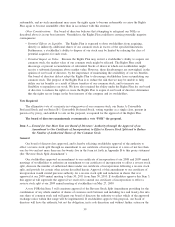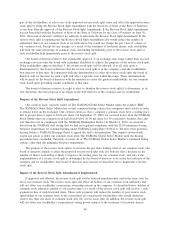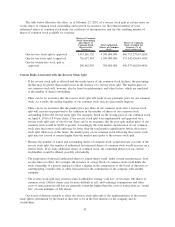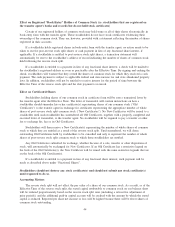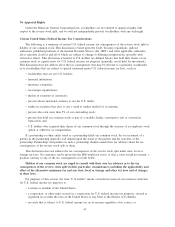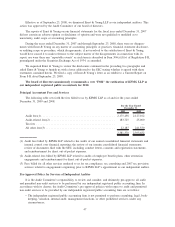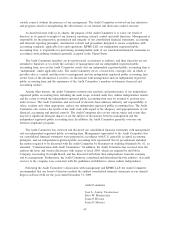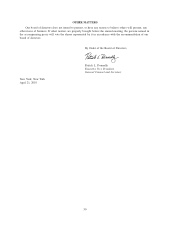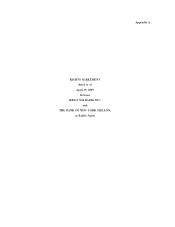XM Radio 2009 Annual Report Download - page 49
Download and view the complete annual report
Please find page 49 of the 2009 XM Radio annual report below. You can navigate through the pages in the report by either clicking on the pages listed below, or by using the keyword search tool below to find specific information within the annual report.
The table below illustrates the effect, as of February 23, 2010, of a reverse stock split at certain ratios on
(i) the shares of common stock outstanding and reserved for issuance, (ii) the reduced number of total
authorized shares of common stock under our certificate of incorporation, and (iii) the resulting number of
shares of common stock available for issuance:
Shares of Common
Stock Outstanding
plus Shares of
Common Stock
Reserved for
Issuance
Total Authorized
Shares of Common
Stock
Shares of Common
Stock Available for
Issuance (% of
total authorized)
One-for-two stock split is approved .... 3,633,286,720 4,500,000,000 866,713,279(19.26)%
One-for-ten stock split is approved..... 726,657,344 1,300,000,000 573,342,656(44.10)%
One-for-twenty-five stock split is
approved . ..................... 290,662,938 700,000,000 409,337,062(58.48)%
Certain Risks Associated with the Reverse Stock Split
• If the reverse stock split is effected and the market price of our common stock declines, the percentage
decline may be greater than would occur in the absence of a reverse stock split. The market price of
our common stock will, however, also be based on performance and other factors, which are unrelated
to the number of shares outstanding.
• There can be no assurance that the reverse stock split will result in any particular price for our common
stock. As a result, the trading liquidity of our common stock may not necessarily improve.
• There can be no assurance that the market price per share of our common stock after a reverse stock
split will increase in proportion to the reduction in the number of shares of our common stock
outstanding before the reverse stock split. For example, based on the closing price of our common stock
on April 9, 2010 of $.99 per share, if the reverse stock split were implemented and approved for a
reverse stock split ratio of one-for-ten, there can be no assurance that the post-split market price of our
common stock would be $9.90 or greater. Accordingly, the total market capitalization of our common
stock after the reverse stock split may be lower than the total market capitalization before the reverse
stock split. Moreover, in the future, the market price of our common stock following the reverse stock
split may not exceed or remain higher than the market price prior to the reverse stock split.
• Because the number of issued and outstanding shares of common stock would decrease as result of the
reverse stock split, the number of authorized but unissued shares of common stock would increase on a
relative basis. If we issue additional shares of common stock, the ownership interest of our current
stockholders would be diluted, possibly substantially.
• The proportion of unissued authorized shares to issued shares could, under certain circumstances, have
an anti-takeover effect. For example, the issuance of a large block of common stock could dilute the
stock ownership of a person seeking to effect a change in the composition of the board of directors or
contemplating a tender offer or other transaction for the combination of the company with another
company.
• The reverse stock split may result in some stockholders owning “odd lots” of less than 100 shares of
common stock. Odd lot shares may be more difficult to sell, and brokerage commissions and other
costs of transactions in odd lots are generally somewhat higher than the costs of transactions in “round
lots” of even multiples of 100 shares.
Our board of directors intends to effect the reverse stock split only if the implementation of the reverse
stock split is determined by the board of directors to be in the best interests of the company and its
stockholders.
42


